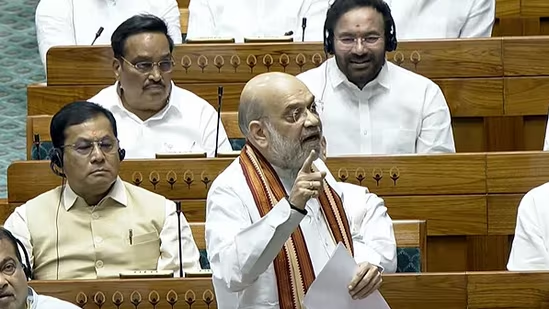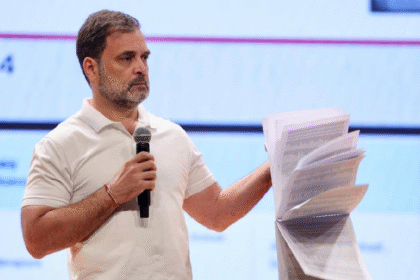The Attack at Pahalgam and National Shock
On a quiet morning in the picturesque town of Pahalgam, nestled in the Anantnag district of Jammu and Kashmir, the serenity was shattered by a sudden, coordinated attack. The heavily armed assailants, believed to be linked to Pakistan-based terror outfits, opened fire on a bus carrying pilgrims and local civilians. What followed was not just a brutal act of terrorism, but a direct provocation that sent ripples through the security and political corridors of India.
The attack, executed with precision and intent, left multiple civilians injured and created widespread panic among the local population. As images of blood-stained roads and shattered glass surfaces flooded national media, outrage erupted across the country. Political leaders condemned the attack unequivocally, calling for swift and decisive retaliation.
Union Home Minister Amit Shah, while attending an emergency security briefing, assured the nation that the perpetrators would not go unpunished. Within hours, elite counter-terror teams, including units from the Indian Army, Jammu and Kashmir Police, and paramilitary forces, were mobilized. Thus began the planning of what would later be known as Operation Mahadev.
The Launch of Operation Mahadev
Operation Mahadev was launched under the direct oversight of senior security officials, with real-time updates being relayed to the Home Ministry. The goal was not merely to avenge the Pahalgam attack but to dismantle the entire module responsible for its execution.
Intelligence inputs indicated the attackers had retreated to a dense forest area near the higher reaches of South Kashmir. Using high-resolution drones, satellite imagery, and human intelligence from local informants, security forces began cordoning off suspected hideouts.
The multi-pronged offensive began with an aerial survey, followed by the insertion of ground forces. Armed with night vision and thermal sensors, troops moved stealthily through the treacherous terrain. What followed was an intense gun battle that lasted several hours, culminating in the neutralization of three heavily armed militants. All three were confirmed to be involved in the Pahalgam attack.
Union Home Minister Amit Shah, addressing the Lok Sabha, confirmed the success of the operation. “I want to inform this House and the nation that all three terrorists involved in the Pahalgam attack have been neutralized in Operation Mahadev. Our security forces have once again demonstrated exemplary courage and precision,” he said, drawing applause from lawmakers across party lines.
Ground Reports and Local Reactions from Pahalgam
As news of Operation Mahadev’s success spread across the region, the streets of Pahalgam—still under the shadow of the recent violence—began to show signs of guarded relief. Locals, who had spent the previous days under curfew and constant surveillance, cautiously stepped out, their faces reflecting a mixture of trauma and gratitude. Shops reopened, albeit slowly, and children returned to schools under tight security cover.
Several survivors of the attack, recovering in hospitals in Anantnag and Srinagar, expressed relief and hope. One of them, 34-year-old Shahid Ahmad, who was on the targeted bus, recounted the terrifying ordeal. “They fired without warning. I still remember the screams. It felt like time had frozen. I didn’t think I’d live to see my children again,” he said, his voice breaking. On hearing of the neutralization of the attackers, he nodded silently, tears pooling in his eyes.
Local political figures, including officials from the Jammu and Kashmir administration, visited the affected areas. Lieutenant Governor Manoj Sinha held a press briefing, lauding the courage of the security personnel. “This operation is a message—not just to the perpetrators, but to every citizen—that justice will be swift and our resolve unbreakable.”
Civilians who were previously fearful of cooperating with the security establishment were now seen speaking more freely to media and law enforcement. According to police sources, local tip-offs had played a key role in confirming the militants’ location. “These people are tired of bloodshed. They want peace, they want tourism, they want development. And that’s only possible if they reject this culture of violence,” said a senior police official stationed in Anantnag.
In the days following the operation, tricolours were spotted fluttering on rooftops across villages in Pahalgam—a quiet but powerful symbol of solidarity and defiance.
Strategic Insights and Intelligence Coordination
Behind the swift execution of Operation Mahadev was a framework of deep strategic intelligence and inter-agency coordination. Senior officials at the National Investigation Agency (NIA), Intelligence Bureau (IB), and Research and Analysis Wing (RAW) had been tracking chatter and satellite signals in the Kashmir valley weeks before the attack. According to sources in the Home Ministry, intelligence had pointed to a possible infiltration attempt by foreign-trained militants operating through the Poonch and Rajouri sectors.
It was this early warning mechanism that allowed Indian security forces to mobilize so quickly post-attack. “We had intercepted unusual movement and communication in southern Anantnag, especially near the Lidder Valley, but the attack was more brutal and better coordinated than anticipated,” said a retired IB officer familiar with the operation.
A central command room was set up in Srinagar to serve as the operational nerve centre. Daily briefings and live drone surveillance footage were relayed to ground troops and senior bureaucrats alike. The synergy between intelligence agencies and military units was said to be the best seen in a decade, reflecting India’s enhanced capability to respond to asymmetric warfare.
Cyber surveillance also played a role. Analysts in Delhi working with military intelligence units tracked digital footprints—encrypted messages, burner phone activity, and VPN-based internet usage—that helped triangulate the location of the terror module. According to a defense cyber specialist, this “digital mapping” was instrumental in defining the contours of Operation Mahadev.
Furthermore, human intelligence from surrendered militants and local informers enabled pinpoint targeting. Several sources embedded in civilian populations reported sightings of the attackers shortly after the incident, which helped form an accurate pursuit corridor.
This multi-layered intelligence approach demonstrated how India is evolving its counter-terrorism playbook: blending boots-on-ground force with real-time tech, data science, and cross-agency cooperation.
Political Reactions and Parliamentary Unity
The political aftermath of Operation Mahadev was as significant as the operation itself. In a rare display of bipartisan solidarity, members of both the ruling and opposition benches united to applaud the courage of the armed forces. Inside the Lok Sabha, Home Minister Amit Shah’s announcement of the operation’s success drew a standing ovation. For a few minutes, political rivalry took a back seat to national unity.
Prime Minister Narendra Modi, addressing the media outside Parliament, remarked, “This is a proud moment for every Indian. Our forces have proven once again that terrorism will be met with an iron fist. I congratulate our security personnel for their valour and precision.”
From the opposition, Congress leader Mallikarjun Kharge also extended praise. “When the nation is under attack, politics must be kept aside. We welcome the swift action taken by the government and the bravery of our soldiers. We stand with the people of Pahalgam.”
Regional leaders, including Omar Abdullah and Mehbooba Mufti, expressed mixed reactions—welcoming the successful operation but urging a long-term policy focus on peacebuilding in Kashmir. “We applaud the neutralization of terrorists. But to truly secure Kashmir, we must create an ecosystem that denies terror any moral, political, or financial ground,” said Abdullah.
Several Parliamentarians demanded a white paper on cross-border terrorism and a special discussion on national security doctrine. Others proposed increased central funding for J&K development schemes to counter radicalization through economic upliftment.
Beyond the walls of Parliament, civil society groups, veterans’ organizations, and youth forums echoed this sentiment of unity. Social media was flooded with hashtags like #OpMahadev, #SaluteOurForces, and #JusticeForPahalgam. In a polarized political climate, Operation Mahadev seemed to temporarily bridge ideological divides, channeling national attention toward resilience and counter-terror preparedness.








